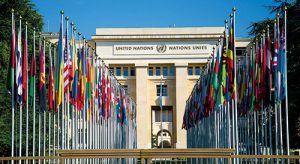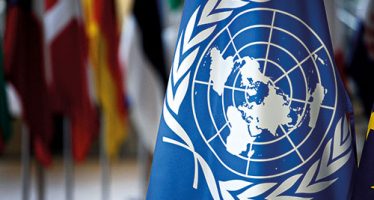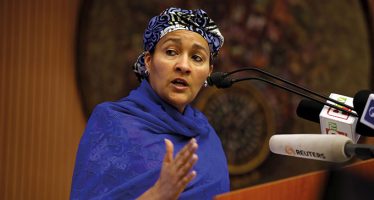UNCTAD’s World Investment Forum: Looking for a Way Out of the Lucas Paradox

Geneva: United Nations
Any and all talk about a determined, sustained, and final push to eradicate poverty from the face of the earth revolves around a single question, one often lost in the peripheric chatter: How best to allocate the world’s savings?
The answer is deceptively straightforward and involves doing the right thing by the investors who own or manage those savings. What this entails is up for discussion at the 10th annual World Investment Forum (WIF) set to take place from October 22 to 26 at the Palais des Nations in Geneva, the United Nations’ European headquarters.
The event, organised by the United Nations Conference on Trade and Development (UNCTAD) brings together all stakeholders in the global development value chain, from steely-eyed fund managers to starry-eyed idealists, a vast and diverse universe held together by experienced policy advisors and assorted experts in various fields related to growing something out of (nearly) nothing, otherwise known as development economics.
Since the first WIF took place in 2008, the world has changed: it has suffered a Long Recession, entered an equally long expansion phase, and managed to successfully implement an ambitious set of Millennium Development Goals. Just as the Asian financial crisis of the 1990s did, the Long Recession – sparked in the United States but mainly, though not exclusively, focused on Europe – saw the accumulation of a savings glut created by policies to hedge against future cash crunches. In times of crisis, creditor nations usually fare much better than those in the red.
Alternatives to Aid
Perhaps even more importantly, the global development agenda as compiled and driven by the UN has come to recognise that dispensing aid – while certainly useful and welcome – is not the most effective way to end world poverty. Aid, even at today’s near-record volumes, offers incidental relief and seldom, if ever, sets the recipient nation on the path of sustained growth.
The reformulated mantra of the global development agenda now reserves a leading role for the formerly eschewed private sector whose untold billions must be mobilised for, and channelled towards, those countries – now called markets in tune with the new philosophy –lagging in development or mired in poverty.
The updated mindset, already reflected at last year’s WIF in Doha, includes the ditching of most appeals to conscience. With a few exceptions, investors are seldom moved by humanitarian reasons. In Doha, pragmatism prevailed over woolliness. UNCTAD, formerly a bastion of leftish progressive thought, has become a UN agency that leverages knowledge and experience to make a clear-cut business case for development.
“The eradication of world poverty can be made into a profitable pursuit with the potential to add untold trillions to the bottom line of private enterprise as millions of formerly marginalised people join the market as consumers.”
UNCTAD’s message to the private sector is simplicity itself, and rather brilliant: The eradication of world poverty can be made into a profitable pursuit with the potential to add untold trillions to the bottom line of private enterprise as millions of formerly marginalised people join the market as consumers.
UNCTAD may, in fact, owe a debt of gratitude to China. Without much assistance from a sceptical outside world, the People’s Republic demonstrated how a desperately poor nation that suffered a string of unspeakable tragedies can reshape and reinvent itself in a single generation.
Lessons from China
When, in the late-1970s, the reformist Deng Xiaoping emerged from the Cultural Revolution and outmanoeuvred his opponents to assume the de facto leadership of the country, China’s per capita income (PPP) hovered around the $200 dollar mark. Last year, China boasted a per capita income in excess of $15,500. The country is now well on its way to progress from middle income to high income status.
The lesson from China is that, politics aside, sensible economic policies can make or break an economy. For all its open-door qualities, that lesson sparked a global shift in development thinking: countries must “own” their policies – as opposed to being told what to do – and encouraged to adopt a workable model geared to tangible results. This is not quite the contradiction it would seem.
The morally-pure approach to development previously furthered – good governance for its own sake and that of the well-being of the nation – does not always yield the expected results. Many rulers, even those democratically elected, often say lofty things to please their audience, but such expressions of good intent may hide a different and somewhat less enlightened agenda that takes its cue from purely personal and/or political considerations.
The question before the WIF, as it unfolds in Geneva, is how to convince the world’s least developed countries (LDCs) which policies to adopt, implement, and adhere to for private investors to take an interest – and release the funds required to accelerate growth and development. Talk about the socially equitable distribution of the fruits of future development is premature. The pie comes before its carving up.
The Lucas Paradox
Estimates of the actual size of the much-reported global savings glut vary wildly and are probably all wrong: it is not a metric easily captured. Some argue there is no such thing, just a vast pile of money parked in low-yield and possibly illiquid instruments. A considerable pool of funds has been looking for yield in all the wrong places. This constitutes the essence of the Lucas Paradox, first detected, analysed, and described in 1990 by Robert Lucas of the University of Chicago (winner of the 1995 Nobel Memorial Prize in Economic Sciences).
Lucas formulated his paradox after observing that the neoclassical model failed to explain the lack of significant capital flows to countries where the marginal product of capital is (much) higher than elsewhere. A well-functioning market should, he argued, direct excess savings to where the return is highest. At the time, the return on invested capital in India could be up to 60 times higher than in the United States, no appreciable volumes of capital were moving into that country.
Since its first edition 10 years ago, the WIF has been trying to resolve this conundrum, central to the funding of the Sustainable Development Goals (SDGs). Emerging, pioneering, and LDC markets usually offer fantastic returns to investors, yet Mr and Mrs Moneybags still fail to move, and show precious few signs of their willingness to change policies and procedures for the allocation of resources they command.
Whose Money and Where Is It?
Though the savings glut is hard to pin down or quantify, its existence – much like the mass of the elusive Higgs Boson particle – may be inferred from observable effects. Take the recent transfer of Brazilian soccer player Neymar from FC Barcelona to Paris Saint-Germain for a record-setting sum of €222m.
Bankrolled by owner Qatar Sports Investments, the club can hardly expect a profit out of the Brazilian star player, even if its stadium fills to capacity for every game and Neymar shoots his team to the finals of the Champions League. But profit is not so much the point here; it is about projecting a positive image of Qatar. Qataris set to return to a record-setting current account surplus as its revenues from natural gas prices increase along with the recovery of world oil prices.
The story is not much different across the English Channel, where investors from countries that enjoy significant surpluses on their current accounts have been buying up nearly all assets they can get their hands on, regardless of price. Here, the enticement – until Brexit – was political stability, sound government, and the rule of law. The same class of investors have also bought some $6tn worth of US treasury bonds since the late 1990s. In Europe, the demand for safe investment havens drove the interest rate on German and Dutch government bonds into negative territory, allowing both countries to actually get paid for debt, while underscoring the peculiarities of the Lucas Paradox.
Contrary to popular belief, the global current account metric is not necessarily a zero-sum proposition. Over the long run, surpluses and deficits net out to exactly zero as per the force of logic – if one country “borrows” through its c/a deficit, then another one must be willing to “lend” from its surplus. Things look rather different on a shorter timescale: countries can – and do – keep part of their surplus in reserve. The International Monetary Fund has found that since about 2002, the world has consistently run a current account surplus, which last year amount to an estimated $300bn.
This money did not flow into someone’s capital account. The savings glut started to grow towards the end of the 1990s as the emerging market economies of Asia sought to increase their resilience to external shocks by paying-off debts and increasing domestic saving rates in a form of delayed gratification applied on a national scale. China initiated the trend by accumulating vast current account surpluses and stashing a significant part of the proceeds in the country’s foreign exchange reserve – which in July 2018 amounted to almost $3.2tn. Observing differences in scale, most of the former Asian Tigers, tripped but never down and out, followed suit.
Benefiting rather handsomely from the euro’s design flaws, Germany took over from China as the world’s current account surplus champion in 2011. The country’s severely undervalued exports inundated a world amazed by relatively cheap marvels of Teutonic engineering. In Europe, tilted demographics play an outsized role in the creation of the savings glut as people nearing the retirement age save a larger part of their earnings compared to young people just starting out in life. In a continent where young people are scarce, this makes a difference.
The worryingly large c/a deficits sustained in the Anglophone world are predominantly a sign of the relative health of its two major economies. Both the US and the UK offer attractive business environments that attracts more capital than is needed, resulting in asset price bubbles.
Eurozone member states – led by Germany – are also aware of the inherent weaknesses of their shared currency, which is still a work in progress. To avoid a repeat of the 2008/9 financial troubles, eurozone members are encouraged to build their reserves and pursue solid c/a surpluses.
There is, for now, no scenario that includes a drawdown of the global savings glut. For Europe, welcoming more immigrants – boosting the ranks of the young – might do the trick, but the option remains a political no-go area. Perhaps, the upcoming wave of retirees in Europe and, to a lesser extent, North America may help – a little. In retirement, people draw on their savings instead of adding to them.
The only sure-fire way of dipping into the savings glut is for surplus countries to spur consumer demand via the direct spending of their national incomes and reserves as opposed to quantitative easing and other artificial constructs. Increasing consumption in surplus countries has the added advantage of helping along emerging, pioneer, and other ambitious markets since all that added demand must somehow be met and will lead to a new commodity super-cycle.
Which brings us back to the beginning: countries stand the best chance of attaining the rapid growth needed to eradicate poverty when their livelihoods improve – either because they obtain better prices for their resources or because sensible policies attract investors. The latter part is well within the purview of the World Investment Forum, as long as its participants first manage to solve the Lucas Paradox.
The key to that one is good governance. The search for shortcuts has, so far, yielded no other approach.
That reluctance in the face of opportunity may yet subside. A significant number of LDCs have started to recognise the importance of good governance, enticed, perhaps, by the riches to be tapped into and helped along by the prodding of restless populations that have discovered – and embraced – online platforms.
Particularly in Africa, young people are no longer willing to keep silent. They boldly take their governments to task over the lack of opportunities and underdevelopment. Knowing full-well what the modern world has to offer, these masses will not be huddled for much longer in poverty. The amount of talent available thanks to improved education – one of the MDGs almost realised – is staggering and constitutes an asset that investors will not be able to ignore for much longer.
The Time is Now
For now, however, they do: UNCTAD’s own statistics show a 21% year-on-year decline in foreign direct investment (FDI) in Africa – shrinking to $42bn in 2017. Morocco proved the exception thanks to sizeable investments in car-assembly plants. On the other end of the scale was Southern Africa, which last year registered a 66% slump in FDI to a paltry $3.8bn. Happily, UNCTAD Director James Zhan, who heads the organisation’s Investment and Enterprise Division, expects FDI to rebound this year. “The beginnings of a commodity price recovery, as well as advances in interregional cooperation through the signing of the African Continental Free Trade Area agreement, could encourage stronger FDI flows to Africa in 2018, provided the global policy environment remains supportive,” he said.
Volumes are still too low to make a marked difference in the rate of growth. Home to about 15% of the world’s population, Africa attracts only about 5% of global FDI flows. According to UNDP chief economist Ayodele Odusola, the best moment to invest in Africa is now: “Africa is the most profitable region in the world,” he says. “Between 2006 and 2011, Africa had the highest rate of return on inflows of foreign direct investment – 11.4%. This compared to 9.1% in Asia and 8.9% in Latin America and the Caribbean. The global figure is 7.1%.”
But while the higher rate of return on capital may mitigate risk, the gap with risk-free yield obtained elsewhere is slowly closing as interest rates in North America and Europe are bound to rise, and fund managers are under less pressure to look for yield in faraway places.
You may have an interest in also reading…
An Inspiring Trajectory
Amina J Mohammed has been called one of the world’s greatest leaders (Fortune magazine), Diplomat of the Year (Foreign Policy
Amina J Mohammed: Energy for Sustainable Goals
If, by way of magic, cynicism and indifference could be banned, the world would undoubtedly be a much happier place.


















































































